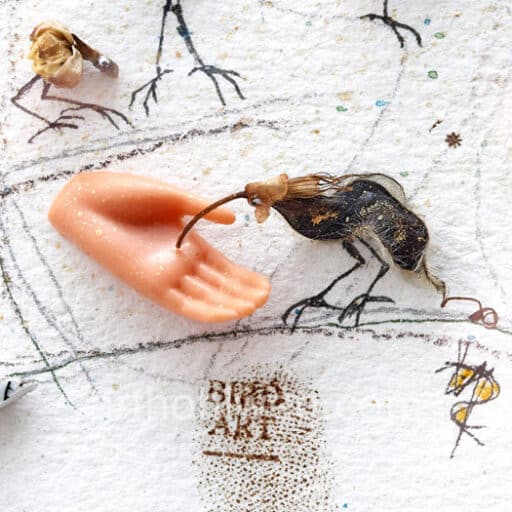In search of a new romanticism

For her miniature collages, Magdalena Hohlweg collects trivial remnants wherever she goes and stands. The very last questionable crumbs, picked up from sidewalks and forest paths, are elevated to art here. Precise alignment and fixation on watercolor paper and additions with fine line drawings – the result is a panopticon of unique characters that amaze and enchant as confusingly real-looking insects or tiny bird creatures. Despite fragile pieces of plastic or paper on scrawny plant remains – the small scenes have something extremely aesthetic about them. But isn’t this an outdated and romantic view of a paradisiacal world that no longer exists? Don’t we need new ways and perspectives?
MagdalenaHohlweg: “Absolutely! Because we are in the midst of a huge turning point! On our current path, which leads us ever higher, faster and further, we are sorting out what is not profitable. As early as the beginning of industrialization around 1800, it was therefore no longer romanticism but rationality that was in demand. From then on, nature was merely a resource. With his pioneering technical achievements, man as the most important element of existence places himself at the center of the universe. An anthropocentric view of the world has dominated life on our planet ever since. We want to disempower nature in order to subjugate it to our purposes – and to do this we must also demystify it. Parallel to industrialization, art also frees itself from an exaggerated worship of nature, which has been a changing but always central theme of art at least since cave painting, sometimes as a divine source of creation, sometimes as an evil demon. With the onset of industrialization, however, the art scene was dominated by intellect rather than sensuality. Abstract trends prevailed. The romanticism of nature and euphemism are outdated. Anyone who paints ‘too beautifully’ is still easily suspected of escapism, of fleeing reality.
At present, however, the image of man’s omnipotence is crumbling – the age of the Anthropocene is coming to an end. Nature is becoming important again and is thus once again becoming the focus of art. Everything is being viewed with a new willingness. Realism, for example, which was often ridiculed as transfiguring and outdated before the turn of the millennium, is now even being exaggerated in hyperrealism. Because we want to be very close to nature again, which we now believe is almost lost. Even cave painting is making a comeback with street art – at the same time as the digital revolution and in search of the neglected soul of our anonymous dwellings. Because just like thousands of years ago, we still have the same longings. We realize that it is not in our nature to simply leave them behind. Many man-made values and truths are currently being put to the test – we are confronted with the sum of our errors. We have taken everything apart down to the smallest detail, categorized, analysed, rationalized and sorted out – but we must have overlooked something crucial in the process.”

Magdalena Hohlweg takes us on her search for it. And not in distant places of longing, but where we are walking and standing right now. The miniature collages take a hopeful look at our everyday world, which offers unexpected possibilities in the smallest detail if we are prepared to engage with them. This appreciative view of the most banal remnants also allows us to reflect on widespread gigantism. Because the monumentality in which we humans prefer to view ourselves is shaky. In view of our all-encompassing failure, it is now appropriate to look for opportunities for a new beginning in the fragility of our existence. This requires more than reason. It is crucial for our human survival that we relearn a compassionate approach to nature and to ourselves.
It’s time for romance 2.0
